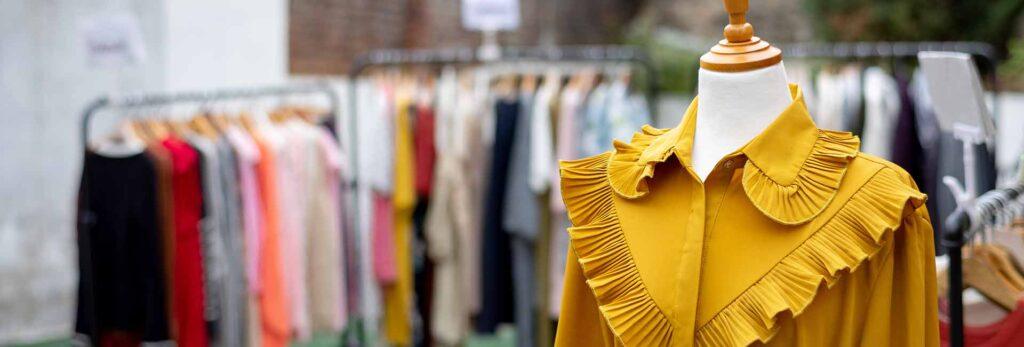10 May What is sustainable and ethical fashion, and 10 reasons to love and not to love it
Fashion industry is one of the most polluting industries in the world generating huge amounts of greenhouse gases and depleting precious environmental resources. At the same time, the world consumes 80 billion new pieces of clothing a year, which is 400% more than we did 20 years ago. We are in the middle of the climate crisis and clothing crisis at the same time. Responsible fashion – sustainable and ethical – aims to solve both of them.
In a nutshell: sustainable and ethical fashion is an approach towards sourcing, manufacturing and designing clothes in a responsible and conscious way that accounts for their environmental and socioeconomic impact.
Ideally this approach is incorporated across a garment’s full life cycle, from the first design idea to a garment’s disposal.
Components of responsible fashion
Responsible fashion comes in many shapes and forms – sustainable fashion, fair and ethical fashion, reused fashion, high-quality fashion, and many more.

Sustainable fashion
Sustainable fashion is a more general term for describing responsible fashion and it focuses mostly on the environmental impacts of fashion. It asks fashion brands:
Are textiles made of eco-friendly materials like organically grown fibers that avoid the use of pesticides and insecticides, recycled fabrics, and are they biodegradable?
Are there any sustainable industry standards applied (for example, Global Organic Textile Standard (GOTS) or Fairtrade)?
Are there any energy-saving and water-saving initiatives during production?
What initiatives are in place to reduce the environmental impact of textile production? Are natural dyes used or no-waste pattern-making?
Is the clothing made on-demand?
Are recycled and recyclable materials used for garment packaging?

Ethical fashion
Ethical fashion focused on the moral implications of the fashion industry – human rights, inclusivity, supply chain transparency, and animal rights. It asks fashion brands:
Are fashion workers paid fairly for making garments?
Are their work conditions safe?
Are Fair Trade policies and certifications respected?
Are animal materials used to produce clothing and if so, how fairly are animals treated?
How transparent are they in sharing fair work policies and their supply chain practices?
Do they preserve craft traditions, use hand-made, and artisan-crafted garments?
Do they pay attention to inclusivity and diversity when designing clothing? For example, do they account for sizes XXL and up to address needs of women of all shapes and complexions?

Reused fashion
Of course, the most sustainable fashion is reused fashion. These are garments that have been already manufactured and used:
Second-hand and vintage fashion (buying from your local thrift store or through platforms like ThreadUp, The RealReal, and Tradesy)
Rented and swapped fashion (sharing clothing, whether it’s your friend or another member of clothing rental communities on Rent The Runaway or Armoire)
Recycled fashion (reusing old clothing for fabrics or redesigning it to create new garments like a brand Chopova Lowena cleverly does)

Timeless and high-quality
Last but not least, responsible fashion is designed with durability and quality in mind. If you purchase quality garments with timeless design, there’s a high chance they will last longer and you’ll be able to create more distinct looks with them.
5 things to love about sustainable fashion
1. Its focus on tackling climate change and socio-economic problems: reducing carbon emissions, water waste, supporting fair work practices.
2. Supporting such a good cause will make you feel better about yourself and be proud.
3. It saves time and money in the long run: by learning to buy less but more quality items, you can create a capsule wardrobe which will help you dress effortlessly and mix and match items better.
4. Its use of natural materials (linen, wool, organic cotton, bamboo) that are not only biodegradable but also feel good on your skin.
5. If you are open to experimentation, sustainable fashion will empower you to be unique. For example, you can be one of the first fashion lovers to try a crossbody made from Pineapple leather, underwear made of bamboo, a denim bag handmade from recycled denim, or a digital garment from DressX.
5 things not to love about sustainable fashion
Unfortunately, sustainable fashion is not for everyone – just yet. Here at Sparkpick we’ve been testing sustainable clothing brands for quite a while, and here are some of the things we think need improvement.
1. Returns can get expensive and not easy
Many of us, especially US fashion consumers, are spoiled by free returns offered by fast fashion brands and marketplaces like Amazon. Returns in sustainable fashion are not that easy and often are not free. There was a time when we spent $50 on shipping the dress and returning it, which certainly felt like a waste of money and time.
2. Shipping takes long
There are sustainable fashion brands that are not yet able to figure out how to speed up shipping and on-demand garment production. You can easily end up waiting a month for the delivery, especially from Etsy stores and new brands.
3. Sustainable fashion can get expensive
If you previously never spent more than $100 on a fashion item, buying sustainable fashion might be a financial stretch. Sustainable fashion costs more money because it ensures high quality fabrics are being used and garment workers are being fairly paid.
4. There’s much greenwashing out there
With sustainability becoming a buzzword, greenwashing has been on the rise as well. There are brands that are trying to communicate their pseudo green practices. That’s why when you start in sustainable fashion, use brand directories like Good on You, Remake, and DoneGood to filter out greenwashing.

5. Hard to recycle old clothing
The problem with clothing disposal hasn’t been solved yet. A year ago we called about a dozen municipal recycling facilities in the Silicon Valley to find a place to recycle clothing, and we couldn’t find any. Turns out most of our friends were occasionally recycling old clothing at the H & M store, which is, ironically, the pioneer of fast fashion.
In sum, sustainable fashion is an amazing breakthrough that the fashion industry has been experiencing. For fashion consumers it has pros and cons, and there’s no need to feel bad about not incorporating new habits into your lifestyle just yet. Small steps count: asking ourselves if we will wear an item at least 30 times before buying it, buying timeless high quality designs, occasionally shopping second-hand and vintage, and keeping an open mind.

